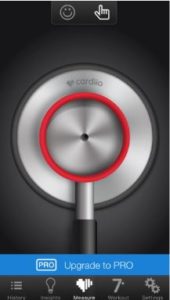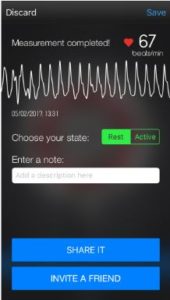By Saúl Martín Rodríguez
APP REVIEW
NAME OF MOBILE APPLICATION
Cardiio – Heart Rate Monitor + 7 Minute Workout
PLATFORM
Compatible with any iOS device (iPhone, iPad, and iPod touch) with iOS 7.0 or later.
COST
Lite version – free; Pro version – $A6.99
Current version is V.3.3.3 which has support to any iPhone, iPad and iPod Touch with iOS 7.0 or later installed.
 ABOUT THE APP
ABOUT THE APP
Heart rate (HR) monitoring is an important component in cardiovascular fitness assessment and training programmes, especially in clinical populations1. Cardiio (figure 1) measures HR (i.e., pulse) at rest and after exercise using imaging photoplethysmography (PPG), i.e., tiny changes in reflected light from either fingers or face which can be detected by the in-built rear camera. PPG is a noninvasive optical method accepted in the clinical use2 for the measurement of arterial oxygen saturation and basically consist of detecting variations of the light absorption caused by arterial blood-volume pulsations. To correctly record HR in the finger mode (figure 2), users should make sure that their fingers are not cold and lightly cover the entire back camera without pressing too hard to avoid blood flow restriction. Additionally, to correctly record HR in the face mode, users should make sure that their face is clearly visible and take the measurement in a well-lit area so the face is well illuminated. A recent study3, using 40 healthy adults without any heart condition or pacemakers, demonstrated the Cardiio app installed on an iPhone 6S to have a very strong agreement both at rest (r = 0.99 for finger, r = 0.97 for face) and after exercise (r = 0.99 for finger, r = 0.97 for face). Moreover, the accuracy of the Cardiio app at rest was ±1.58 beats per minute (bpm) (or ±2.27%) using the finger mode and ±2.28 bpm (or ±3.17%) for the face mode, compared to a pulse oximeter. After moderate to vigorous exercise, the accuracy of the Cardiio app was ±2.97 bpm (or ±2.79%) using the finger mode and ±5.31 bpm (or ±4.50%) for the face mode, compared to the pulse oximeter. These data support the use of Cardiio to accurately measure HR at rest and after exercise, making the app an important tool for educational purposes and/or to support general health and wellness.
 USE IN CLINICAL PRACTISE
USE IN CLINICAL PRACTISE
Adherence to physical activity programmes clearly provides numerous health benefits, perhaps most important of which is a significant decrease in the risk for cardiovascular disease and mortality4. The HR response at rest, after exercise and into recovery is a basic physiological measurement which clearly indicates the fitness level. There are currently several commercially available devices such as activity trackers or HR monitor watches, however, most of them are not scientifically validated or are expensive (>A$100). This easy-to-use and low cost app could be used by clinicians, researchers or in educational environments, or by users to self-monitor their HR at rest and after exercise for self-or clinician review. Therefore, Cardiio will help users to adjust their workout to ensure that they will get favorable results from a physical activity program and/or to gauge their progress.
PROS
- Demonstrated validity compared to a finger pulse oximeter
- Ability to save unlimited participants and trials
- Ability to export data as .csv file
- Ability to synchronize data with Apple Health and RunKeeper (https://runkeeper.com/)
- Integration with social media (Facebook and Twitter) to share data
- Includes the “7-minute workout” which is a high-intensity circuit training program based on a scientific study published in the American College of Sport Medicine´s Health and Fitness Journal
- Multiple language support (English, Dutch, French, German, Italian, Japanese, Korean, Portuguese, Russian, Simplified Chinese, Spanish, Swedish, and Traditional Chinese)
CONS
- iOS only, not available on Android or Windows smartphones
- Validated just in healthy adults
- Validated just with the iPhone 6S
- Need to upgrade to the Pro version to obtain new features (fitness level, potencial life expectancy, endurance score, target heart rate, waveform/graph representation, caloric burn, and calorie-burn estimator) which use validated equations based on scientific publications
REFERENCES
- Arnold JM, Fitchett DH, Howlett JG, et al. Resting heart rate: a modifiable prognostic indicator of cardiovascular risk and outcomes? Can J Cardiol 2008;24 Suppl A:3A-8A.
- Kamshilin AA, Nippolainen E, Sidorov IS, et al. A new look at the essence of the imaging photoplethysmography. Sci Rep 2015;5:10494. doi: 10.1038/srep10494
- Poh MZ, Poh YC. Validation of a Standalone Smartphone Application for Measuring Heart Rate Using Imaging Photoplethysmography. Telemed J E Health 2017 doi: 10.1089/tmj.2016.0230
- Warburton DE, Nicol CW, Bredin SS. Health benefits of physical activity: the evidence. CMAJ 2006;174(6):801-9. doi: 10.1503/cmaj.051351
**************************************
Saúl Martín Rodríguez, @smrodguez, Department of Physical Education, University of Las Palmas de Gran Canaria, Gran Canaria, Spain
BJSM has no commercial conflict of interest the posting of this blog.